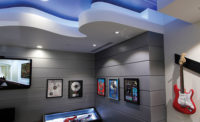The increased focus on health and safety prompted by the COVID-19 pandemic kicked the people-first mindset extolled by standards, such as WELL into high gear. There is strong agreement that workplaces need to be designed with deep commitment not only to occupant satisfaction but to health, well-being and social connection.
At the same time, there is growing conviction amongst the architectural and design community that these goals must be achieved through concern with “equity”—and applied to “real-world” needs—rather than via amenities such as pool tables, private chefs, and other perks; in other words, they are more a matter of how employees are treated than what they are treated to.¹
But what is acoustical equity? And how does one achieve it? These are significant questions, particularly given that the Center for the Built Environment’s post-occupancy survey dataset—one of the largest in the world—shows poor acoustics remains the most significant source of dissatisfaction among workplace occupants.
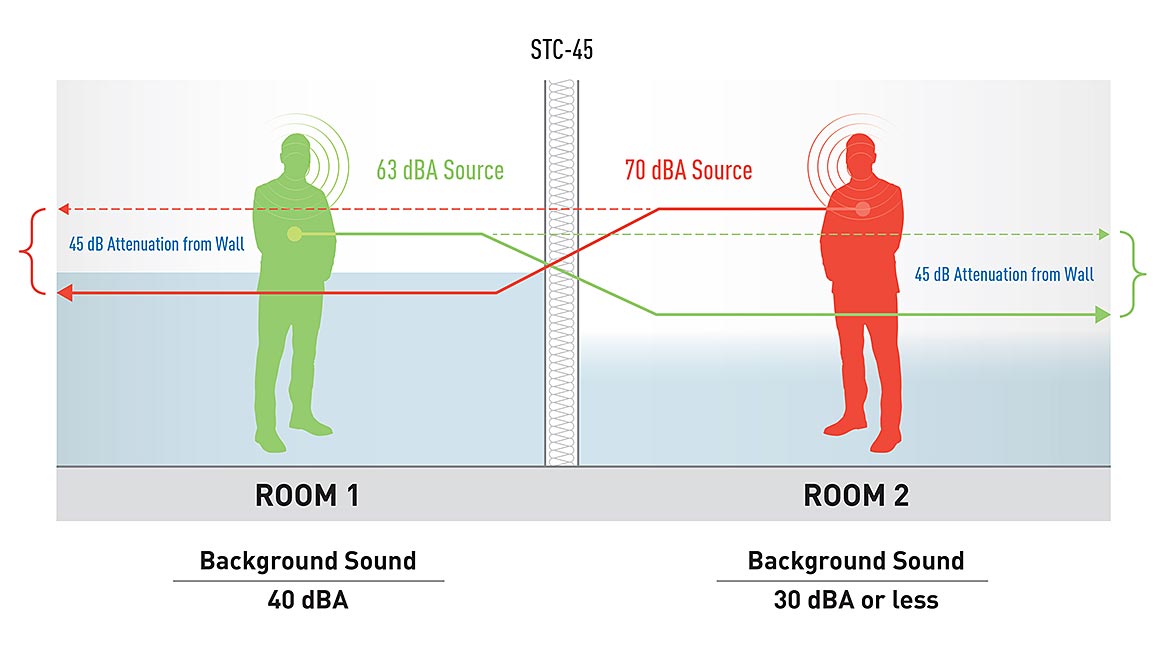 Figure 1: The person (green) in Room 1 speaks at a ‘Casual’ level, while the person (red) in Room 2 uses a ‘Normal’ level (i.e., per Pearsons). Despite the latter’s elevated vocal effort, they enjoy speech privacy due to the higher and consistent background sound level within Room 1. The person in Room 1, on the other hand, does not have speech privacy due to the lower and variable nature of the background sound in Room 2; however, they believe they have privacy because they cannot hear the person in Room 2.
Figure 1: The person (green) in Room 1 speaks at a ‘Casual’ level, while the person (red) in Room 2 uses a ‘Normal’ level (i.e., per Pearsons). Despite the latter’s elevated vocal effort, they enjoy speech privacy due to the higher and consistent background sound level within Room 1. The person in Room 1, on the other hand, does not have speech privacy due to the lower and variable nature of the background sound in Room 2; however, they believe they have privacy because they cannot hear the person in Room 2.
Credit: KR Moeller Associates Ltd.
Acoustical Privacy is Key
Research shows overall acoustical satisfaction is strongly correlated with acoustical privacy; however, it is challenging to use acoustical privacy as a starting point for a conversation about equity because it is not yet addressed by a standardized metric or even a proposed methodology.
Speech privacy, on the other hand, is well-defined and measurable (e.g., using articulation index) and can, therefore, be used in practical ways (e.g., to set expectations during design and estimate occupants’ subjective impression of the built space). In this case, evaluation of acoustical privacy is effectively a review of the signal-to-noise ratio; it considers an intruding “signal” (speech) and its level relative to the background “noise” (or rather sound) in the receiving space.
By way of example, let us turn our attention to the rooms—and occupants—shown in Figure 1:
- Room 1: The red arrows depict an elevated level of intruding noise, compared to the green arrows. This case represents a well-designed space where the combination of the insulating properties of the wall (STC-45) and the constant background sound level of 40 A-weighted decibels (dBA) ensures the noise is not intelligible and/or audible.
Room 2: The green arrows depict a lower level of intruding noise. This case represents a space that fails to consider occupant needs and/or expectations. The combination of the insulating properties of the wall (still STC-45) and the existing background sound level (only 20 dBA or less) in the receiving room is insufficient to ensure acoustical privacy. Although the intruding level of the green source is lower than the red example, it remains intelligible and/or audible.
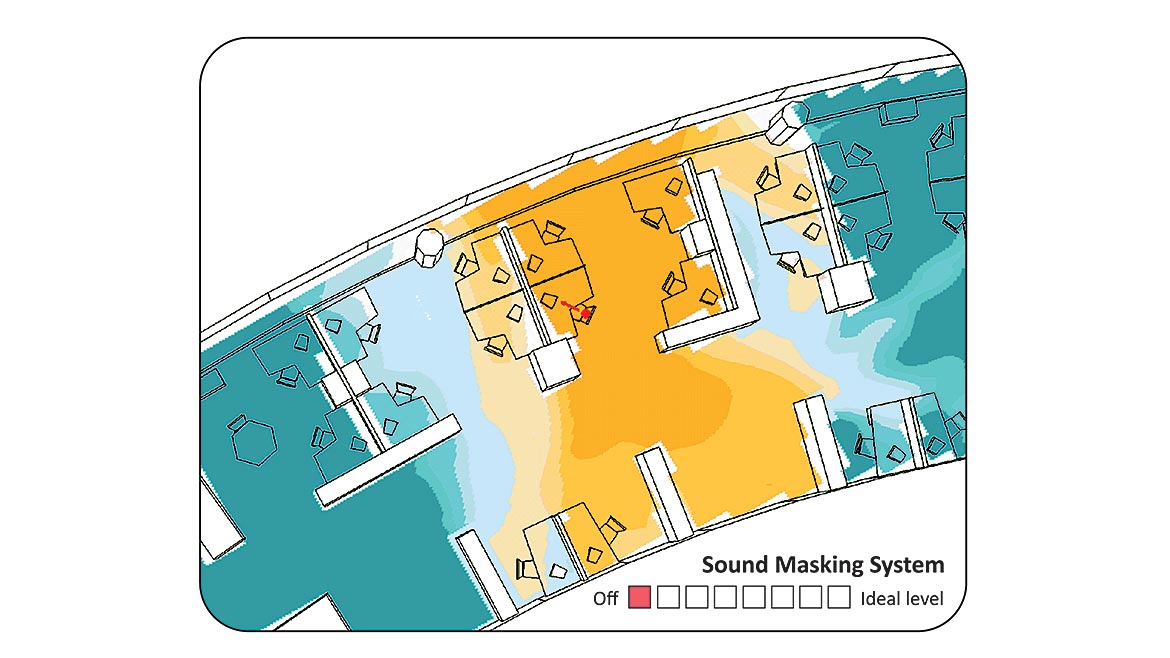 The area of intelligibility around a speaker is not circular. Its shape is determined by numerous factors including the orientation of the person speaking, as well as the physical barriers and absorptive/reflective materials used within the space.
The area of intelligibility around a speaker is not circular. Its shape is determined by numerous factors including the orientation of the person speaking, as well as the physical barriers and absorptive/reflective materials used within the space.
Credit: KR Moeller Associates Ltd.
 When sound masking is applied, the area of intelligibility shrinks.
When sound masking is applied, the area of intelligibility shrinks.
Credit: KR Moeller Associates Ltd.
Now, let us assume the red and green signals are people speaking. The red talker’s voice carries into Room 1; however, it is masked by the background sound. The listener in that room cannot identify and/or understand speech and the red talker enjoys speech privacy. The green talker’s voice is carried into Room 2; however, it is not masked by the background sound and the listener can identify and/or understand speech. The green talker does not have speech privacy.
There are impacts beyond the one-way speech privacy. We accept the red talker has speech privacy because the background sound in the adjoining room masks the received level of their voice. However, the red talker’s perception of privacy is violated because they can hear the green talker. This discrepancy can cause reactive behavioral changes on the part of the red talker (e.g., lowering of voice, avoiding confidential topics). We also accept that the green talker does not have speech privacy because the background sound in the adjoining room does not mask the received level of their voice.
However, the green talker has a false perception of privacy engendered by the fact they are unable to hear the red talker, which can result in breaches of confidentiality.
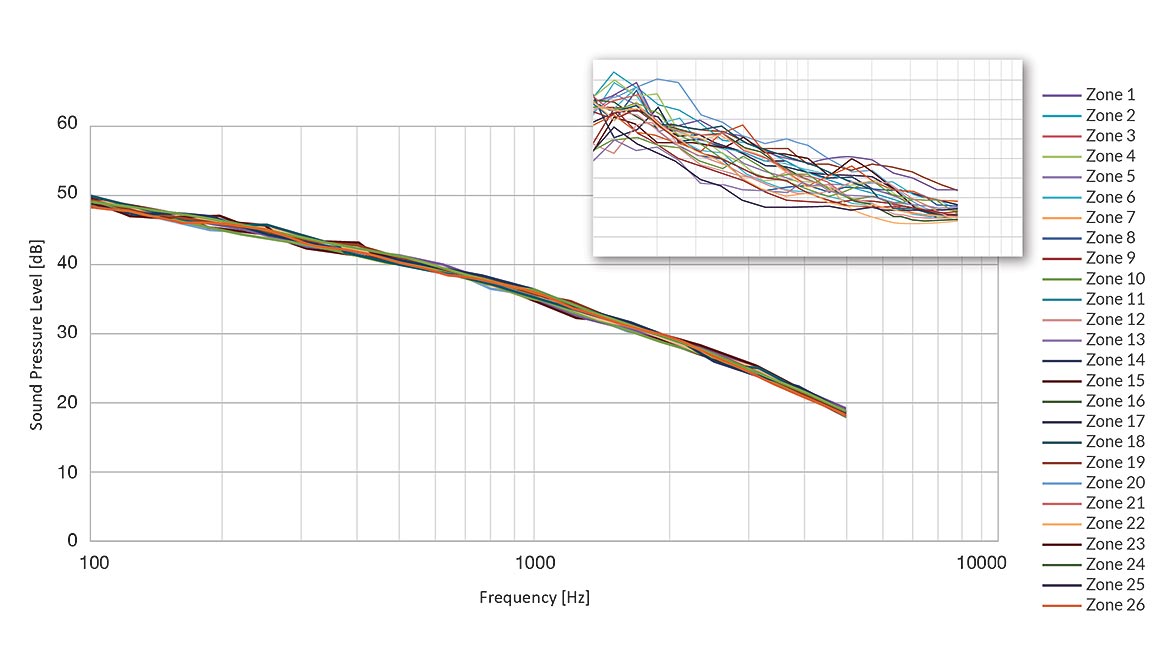 These background sound level measurements were taken in 26 locations within an open plan. Without masking (inset), the occupants experienced varying acoustical conditions across the space. Since masking sound was applied and tuned to reliably meet the National Research Council (NRC) masking spectrum within each small zone, occupants experience a far more consistent level of acoustical privacy and comfort throughout the space.
These background sound level measurements were taken in 26 locations within an open plan. Without masking (inset), the occupants experienced varying acoustical conditions across the space. Since masking sound was applied and tuned to reliably meet the National Research Council (NRC) masking spectrum within each small zone, occupants experience a far more consistent level of acoustical privacy and comfort throughout the space.
Credit: KR Moeller Associates Ltd.
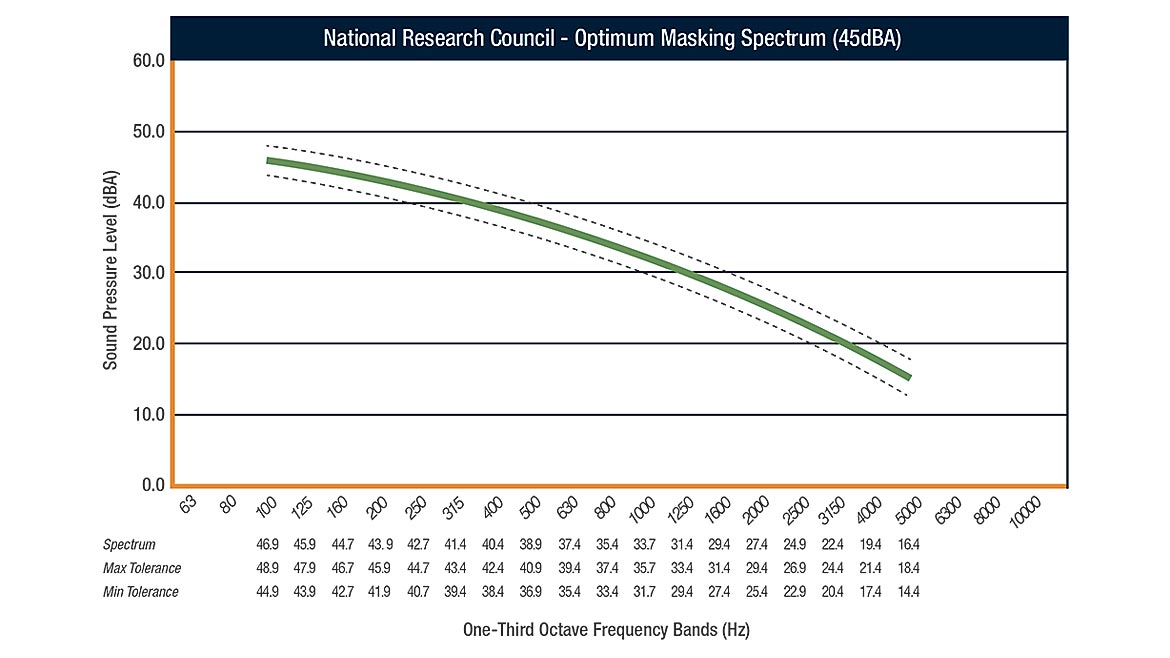 The National Research Council’s (NRC) optimum masking spectrum shown at a level of 45 dBA, as well as one-third octave band tolerances of ±2 dBA.
The National Research Council’s (NRC) optimum masking spectrum shown at a level of 45 dBA, as well as one-third octave band tolerances of ±2 dBA.
Credit: KR Moeller Associates Ltd.
Understanding Acoustical Equity
One can appraise this situation using the basic dictionary definition of “equity” (i.e., fairness or justice in the way people are treated, per Merriam-Webster) and conclude the occupants do not have acoustical equity simply because they do not enjoy equal levels of speech privacy or even perceived privacy. However, there is more to the concept of equity. It involves ensuring the design provides beneficial acoustical conditions throughout the workplace to allow all occupants to function at the highest possible level, in accordance with the goals the space(s) is/are designed to meet and help fulfill.
While some might consider speech privacy a niche application only relevant to particular offices (e.g., law firms), healthcare and military environments, surveys show that lack of speech privacy is the top workplace complaint, indicating it is a broadly applicable concern. Furthermore, this deficiency is not only relevant to occupants of private offices, but to those working within open plans. Although individuals within the latter group are more likely to characterize lowering speech intelligibility as “reducing distractions” rather than “improving speech privacy,” taking measures to achieve this goal means they will have an easier time concentrating on tasks, make fewer errors, and suffer less stress and fatigue.
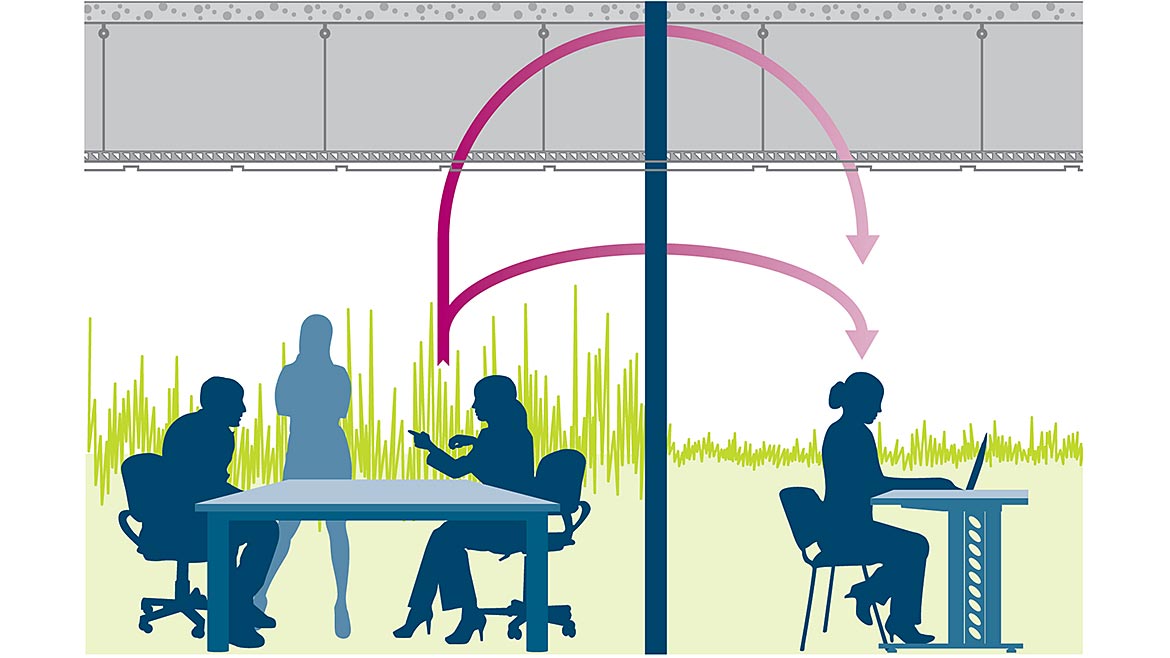 Deck-to-deck construction improves confidentiality, but reduces flexibility and increases costs.
Deck-to-deck construction improves confidentiality, but reduces flexibility and increases costs.
Credit: Acoustic Comfort UK
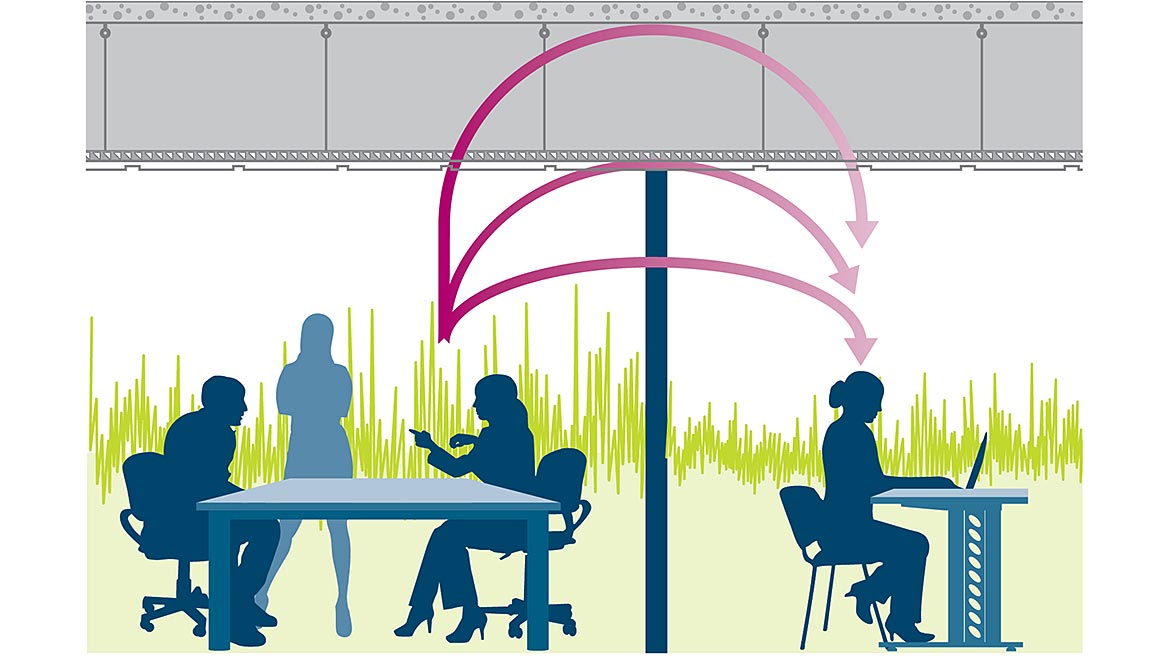 Floor-to-ceiling partitions provide good flexibility, but poor confidentiality.
Floor-to-ceiling partitions provide good flexibility, but poor confidentiality.
Credit: Acoustic Comfort UK
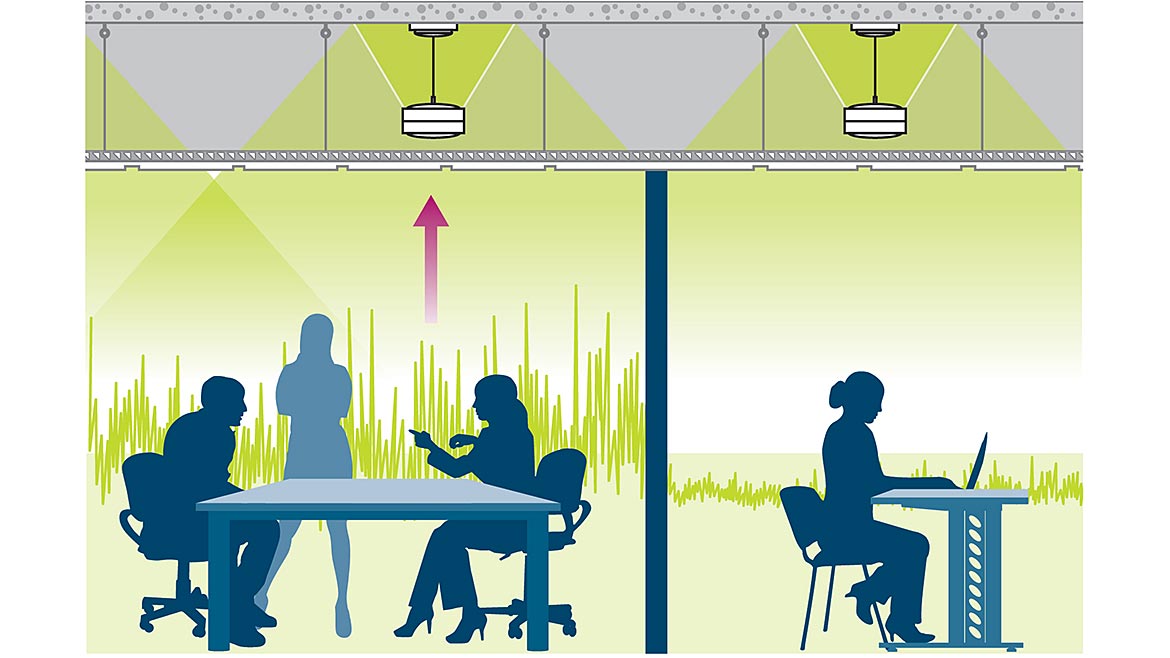 Installation of sound masking manages the ambient noise level in a partitioned office, increasing speech privacy while maintaining the flexibility of floor-to-ceiling partitions.
Installation of sound masking manages the ambient noise level in a partitioned office, increasing speech privacy while maintaining the flexibility of floor-to-ceiling partitions.
Credit: Acoustic Comfort UK
The Need for Control
While speech privacy is not the only acoustical objective, it is a highly sought-after quality with widespread relevance that can serve as the foundation for an acoustical plan within many types of spaces. Any deviations from (e.g., to improve intelligibility in a large training room) or additions to (e.g., biophilic sounds or music in particular spaces) the acoustical conditions required to achieve it must be intentional (i.e., designed to meet a particular goal or occupant need), not unintentional.
Experts maintain that background sound is “probably the most important room variable affecting speech privacy.”² Therefore, if one is to reliably design buildings to function acoustically for their users (e.g., provide adequate speech privacy, freedom from distraction, reduced annoyance, a good night’s sleep, and so on), one needs to establish a known level of spectrally neutral (or balanced) background sound, rather than leaving it—and the end result—in question.
A reliable level and spectrum can only be achieved through the application of the “C” in the “ABC Rule.” While “A” stands for “absorb” and “B” for “block,” “C” stands for “cover”—or, more accurately, “control”—which requires use of a professionally designed and tuned sound masking system. While “C” is the final letter in the rule, it is only because the abbreviation is meant to be memorable and is, therefore, in alphabetic sequence. It is not intended to assign priority level to the acoustical strategies involved or indicate the extent of the role each plays in the outcome. Rather, the rule reinforces the fact that a holistic approach is required for the best results.
It is important to note that this interrelationship—and inter-dependency—of the acoustical features of a built environment is not a wholly occupant-centric consideration. Taking a holistic approach to the execution of an acoustical plan also allows one to gain "system-level" efficiencies that help manage construction-related costs (e.g., lowers STC requirements, permits walls to be built to the ceiling instead of up to the deck), allow for more effective and efficient operation of building-related systems, and avoid post-completion noise mitigation efforts.
Notes
- Talitha Liu and Lexi Tsien in “The Office as We Knew It No Longer Exists,” Azure, September 2020.
- J. Keranen and V. Hongisto, “Prediction of the spatial decay of speech in open-plan offices,” Applied Acoustics, vol. 74, 2013, and W.J. Cavanaugh, W.R. Farrell, P.W. Hirtle, and B.G. Watters, “Speech privacy in buildings,” The Journal of the Acoustical Society of America, vol. 34, no. 4.






